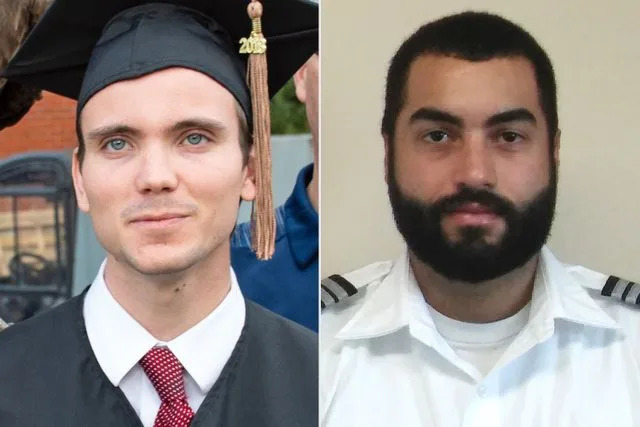Doomed Pilots Cursed and Shouted and Apparently Tried to Save Their Plane Just 1 Second Before Black Hawk Collision
While the Army Black Hawk helicopter that collided with an American Airlines regional passenger jet near Washington, D.C., in January appears to have been oblivious to the danger everyone was in — the American pilots reacted with alarm mere milliseconds before impact.
That’s according to a transcript of the conversations in the cockpit of Flight 5342, between Capt. Jonathan Campos, the pilot, and Sam Lilley, the first officer and co-pilot.
The transcript was released this week by the National Transportation Safety Board as part of a new investigative hearing that started on Wednesday, July 30, and will continue until Friday, Aug. 1.
The NTSB has spent months examining what caused the crash over the Potomac River near Ronald Reagan Washington National Airport on the night of Jan. 29.
All 64 people on the passenger flight were killed along with the three crew members of the helicopter.
Major issues before the collision included the helicopter not seeming to know how high it was in the sky, potentially because of a fault measuring instrument; the decision by air traffic control to allow the helicopter to attempt to manually “pass behind” the larger jet in the infamously congested airspace; and a long-established pattern of military craft flying around the airport in very close proximity to commercial flights — even when it’s not possible for the larger planes to detect them.
With the hearings underway, the NTSB has also released thousands of pages of records from its ongoing probe.
Together, they provide a more complete picture of what was going on in the helicopter, in the passenger plane and in the control tower in the minutes before the deadliest aviation incident in the U.S. in decades.
The cockpit transcript from the Black Hawk helicopter, piloted by Capt. Rebecca Lobach on a flight back to Fort Belvoir in Virginia, shows she and her crew were well aware of the approaching American Airlines plane.
They had been repeatedly warned about it and were going to attempt, they said, to “visually separate” and maneuver around it themselves, which an air traffic controller approved (rather than, as some other pilots have noted, instructing them to pause in the air).
But the pilots of Flight 5342, on their way from Wichita, Kan., did not seem to have any awareness they were on a collision course.
https://people-app.onelink.me/HNIa/kz7l4cuf

facebook (2)
Sam Lilley (left) and Jonathan Campos
The transcript from their cockpit shows they began communicating with air traffic control five minutes before the crash and were soon told to use Runway 33.
They hesitated at that direction and discussed it amongst themselves for about 15 seconds.
“I really don’t want to but I guess, uhhh tell ‘em–“ one says to the other, who starts to reply, “I mean I can just tell ‘em–“
Then the first pilot interjects again: “Nah it’s fine, we got the numbers for it, yeah tell ‘em we’re fine, we’ll do 3-3 we’ll do it.”
In the next several minutes, they prepare the plane to land. Twenty seconds before impact, an automated alert is heard stating “traffic, traffic.”
At almost the exact same time, unbeknownst to the pilots, the Black Hawk helicopter is requesting approval to use “visual separation” and fly around them. (The plane and helicopter could not communicate with each other via radio, only with air traffic control.)
It remains unclear if the helicopter crew knew they were flying above the altitude limit of 200 feet, although Lobach’s instructor, Chief Warrant Officer 2 Andrew Eaves, had notified her at one point about her height and told her to “come down.”
One second before the collision, a clicking sound is heard in the American Airlines cockpit.
One of the pilots says “oh” — and curses.
The other pilot says, more loudly, “Ohhhh ohhhh.”
The NTSB told reporters earlier this year that the data showed Flight 5342 was “beginning to increase its pitch” — conceivably as a last-ditch effort to get out of the way, though that has not been confirmed.
Then they crashed.
Capt. Campos was previously remembered by the Transportation Security Administration for his “outstanding legacy of leadership and duty to others.”
He had been inspired to service, according to the TSA, after his New York City police officer father died when he was 9.
Never miss a story — sign up for PEOPLE’s free daily newsletter to stay up-to-date on the best of what PEOPLE has to offer, from celebrity news to compelling human interest stories.
“He often traveled with his father’s badge and even had a tattoo of the badge with number 4935 on his right shoulder,” the TSA said.
Lilley, Campos’ co-pilot, was planning for his wedding when he died, his father, Tim Lilley, previously told PEOPLE.
“I was so proud when Sam became a pilot,” Tim wrote on Facebook in January. “Now it hurts so bad I can’t even cry myself to sleep.”
Read the original article on People
